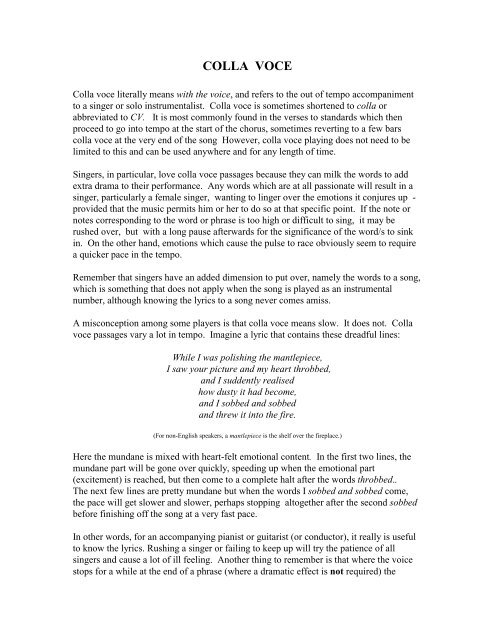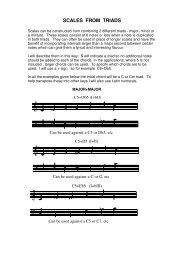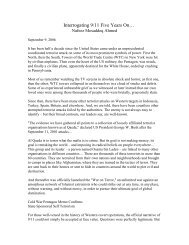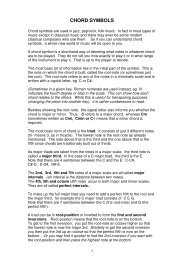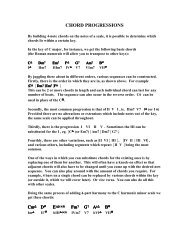You also want an ePaper? Increase the reach of your titles
YUMPU automatically turns print PDFs into web optimized ePapers that Google loves.
COLLA VOCE<strong>Colla</strong> voce literally means with the voice, and refers to the out of tempo accompanimentto a singer or solo instrumentalist. <strong>Colla</strong> voce is sometimes shortened to colla orabbreviated to CV. It is most commonly found in the verses to standards which thenproceed to go into tempo at the start of the chorus, sometimes reverting to a few barscolla voce at the very end of the song However, colla voce playing does not need to belimited to this and can be used anywhere and for any length of time.Singers, in particular, love colla voce passages because they can milk the words to addextra drama to their performance. Any words which are at all passionate will result in asinger, particularly a female singer, wanting to linger over the emotions it conjures up -provided that the music permits him or her to do so at that specific point. If the note ornotes corresponding to the word or phrase is too high or difficult to sing, it may berushed over, but with a long pause afterwards for the significance of the word/s to sinkin. On the other hand, emotions which cause the pulse to race obviously seem to requirea quicker pace in the tempo.Remember that singers have an added dimension to put over, namely the words to a song,which is something that does not apply when the song is played as an instrumentalnumber, although knowing the lyrics to a song never comes amiss.A misconception among some players is that colla voce means slow. It does not. <strong>Colla</strong>voce passages vary a lot in tempo. Imagine a lyric that contains these dreadful lines:While I was polishing the mantlepiece,I saw your picture and my heart throbbed,and I suddently realisedhow dusty it had become,and I sobbed and sobbedand threw it into the fire.(For non-English speakers, a mantlepiece is the shelf over the fireplace.)Here the mundane is mixed with heart-felt emotional content. In the first two lines, themundane part will be gone over quickly, speeding up when the emotional part(excitement) is reached, but then come to a complete halt after the words throbbed..The next few lines are pretty mundane but when the words I sobbed and sobbed come,the pace will get slower and slower, perhaps stopping altogether after the second sobbedbefore finishing off the song at a very fast pace.In other words, for an accompanying pianist or guitarist (or conductor), it really is usefulto know the lyrics. Rushing a singer or failing to keep up will try the patience of allsingers and cause a lot of ill feeling. Another thing to remember is that where the voicestops for a while at the end of a phrase (where a dramatic effect is not required) the
accompaniment has to cover the ground quite quickly as a singer doesn't like to rest forlong.Having the lyrics in front of you is a great help in not getting lost, as it is usually fareasier to follow the words than to follow the notation, especially if the music repeats itselfa lot. When writing colla voce passages out, arrangers should therefore include lyrics onthe accompanyist's music.To make life a little easier, you may like to give this a try. Above the clef or the lyrics,draw a line that goes up when the tempo should speed up, stays straight when it remainsstable, and goes down when there it slows down. Where a pause is required, the line canbe discontinued or a pause mark can be shown. As an example, let's take the first twolines of the lyric on the previous page.F /Gm7 Am7: Ü 4 … rHWhileHIHwasHpo-Hlish-HingHtheBbvHman-Htle-HpieceBo &§H‹rHI: Ü HC7(b9)/HHCx &¡H rHHHDm7HpEb13(+11)G‹sawyourpic-tureandmyheartthrobbedNot every singer would sing it this way, but most would certainly pause on the wordthrobbed.Where an instrumental colla voce passage is required, the pattern is often for the musicto slow down or even come to a stop at the end of each musical phrase. Where there is aparticularly long phrase, it may be played fairly quickly before finally slowing down Infact, playing colla voce can be quite rapid and makes a welcome relief from a slowponderous tempo which would be the alternative.When whole bands have to play colla voce, there is often a problem in everyone trying toco-ordinate their efforts. At times, nods and hand gestures are the only solutions.Let's look at how a chordal passage could look like with a line showing the tempo.
colla voce: 4 4Cv Eb7 Abv G7(b9+5) Em11 A7(x9) Abm9 Db9: C7$ Gb7(-5) Fv Ab7(+11) Dm9 Em7 Fm9 E7(x9+5): Av Eb9 Dv9 Dbv9 Gbv9 C7(b9+5)G7(b9+5)How this chord progression would be played would be at the discretion of thearranger/bandleader - this is just one way. Try playing it over as a band with a soloist.You still have to use your ears, but the general direction of the tempo could be used as aguideline.Sometimes, a rough idea of the starting tempo might be useful, eg. moderate, 120 bpm, orwhatever.Another form of colla voce is where a soloist plays a cadenza on a chord, played by therest of the band. This is often found at the end of a tune, where a soloist is featured.However, it could occur anywhere. In the tune Dung Ho, I start most of the solos off withan cadenza and it is up to the soloist when he/she brings in the tempo and when the bandshould come in. Nodding or lowering the instrument in a rapid gesture (easiest done withhorns than pianos or double-basses!) does the trick.Cadenzas need not be limited to a single chord. Cadenzas on a number of successivechords can be very effective, as writers such as Kenny Wheeler have shown. This is areal test for players. Eye-contact with fellow musicians is important to remember. Or asthe saying goes, the eyes have it...but don't forget the ears.BvØ


